Related Research Articles

A platformer is a sub-genre of action video games in which the core objective is to move the player character between points in an environment. Platform games are characterized by levels with uneven terrain and suspended platforms of varying height that require jumping and climbing to traverse. Other acrobatic maneuvers may factor into the gameplay, such as swinging from vines or grappling hooks, jumping off walls, gliding through the air, or bouncing from springboards or trampolines.
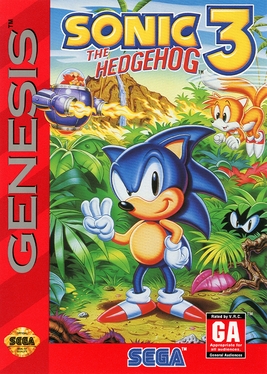
Sonic the Hedgehog 3 is a 1994 platform game developed and published by Sega for the Genesis. Like previous Sonic games, players traverse side-scrolling levels while collecting rings and defeating enemies. They control Sonic and Tails, who attempt to retrieve the Chaos Emeralds to stop Doctor Robotnik from relaunching his space station, the Death Egg, after it crash-lands on a mysterious floating island. Sonic 3 introduces Knuckles the Echidna, the island guardian, who lays traps for Sonic and Tails.

Spyro is a platform game series originally created by Insomniac Games as an exclusive for Sony's PlayStation console. The series features the adventures of the main protagonist of the same name, a dragon. Since the series' introduction in 1998, there have been numerous sequels and a reboot trilogy. The series was originally produced by Universal Interactive, later became known as Vivendi Games; the rights to the intellectual property were acquired by Activision after its merge with Vivendi in 2008.

Klonoa is a platform video game series created by Namco in 1997. It stars Klonoa, an anthropomorphic creature who explores dream worlds. The series includes two main games: Klonoa: Door to Phantomile (1997) for the PlayStation and Klonoa 2: Lunatea's Veil (2001) for the PlayStation 2. A remake of Door to Phantomile was released for the Wii in 2008, and remasters of both games were released in 2022. The series also includes a set of handheld games released between 1999 and 2002 for the WonderSwan and Game Boy Advance.
Toys for Bob, Inc. is an American video game developer based in Novato, California. It was founded in 1989 by Paul Reiche III and Fred Ford and is best known for creating Star Control and the Skylanders franchise, as well as for working on the Crash Bandicoot and Spyro franchises.
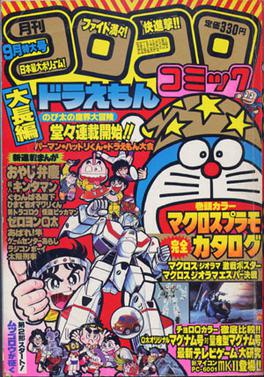
CoroCoro Comic is a Japanese monthly manga magazine published by Shogakukan; established on May 15, 1977. Its main target is elementary school-aged boys. Several of its properties, like Doraemon and the Pokémon series of games, have gone on to be cultural phenomena in Japan.
WayForward Technologies, Inc. is an American independent video game developer and publisher based in Valencia, California. Founded in March 1990 by technology entrepreneur Voldi Way, WayForward started by developing games for consoles such as the Super NES and Sega Genesis, as well as TV games and PC educational software. In 1997, they relaunched their video games arm, placing the company as a contractor for publishers and working on a variety of licensed assets.

Crash Bandicoot is the title character and main protagonist of the Crash Bandicoot series. Introduced in the 1996 video game Crash Bandicoot, Crash is a mutant eastern barred bandicoot who was genetically enhanced by the series' main antagonist Doctor Neo Cortex and soon escaped from Cortex's castle after a failed experiment in the "Cortex Vortex". Throughout the series, Crash acts as the opposition against Cortex and his schemes for world domination. While Crash has a number of offensive maneuvers at his disposal, his most distinctive technique is one in which he spins like a tornado at high speeds and knocks away almost anything that he strikes.

Crash Bandicoot is a video game franchise originally developed by Naughty Dog as an exclusive for Sony's PlayStation console. It has seen numerous installments created by various developers and published on multiple platforms. The series consists predominantly of platform games, but also includes spin-offs in the kart racing and party game genres. The series was originally produced by Universal Interactive, which later became known as Vivendi Games; in 2008, Vivendi merged with Activision, which currently owns and publishes the franchise.

Bubsy 3D is a platformer game developed by Eidetic and published by Accolade. It is the first 3D game in the Bubsy series, and the fourth game in the series overall. The game was released for the PlayStation on November 25, 1996, in North America, with a later European release in August 1997. Bubsy 3D follows the series' titular character, an orange bobcat named Bubsy, who travels to the planet Rayon to stop the alien Woolies, and return safely to Earth.
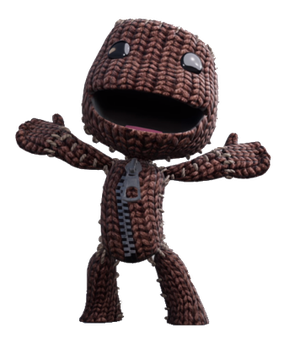
Sackboy is a fictional character and main protagonist of the LittleBigPlanet video game series published by Sony Interactive Entertainment. Introduced in the 2008 video game LittleBigPlanet, Sackboy is a small, anthropomorphic, humanoid doll-like character made of burlap sack with a brown knit pattern by default, with a zip fastener and button eyes. Sackboy was originally designed to be a "blank canvas" for LittleBigPlanet players, and is fully customisable using costumes which are either in-game unlockable content, or purchased as downloadable content (DLC) from the PlayStation Store. Sackboy was jointly created by the founding members of British game studio Media Molecule. Scottish composer Kenneth Young provided the vocal effects for the character from 2008 to 2014.

Spyro is a fictional character and the titular protagonist of the Spyro video game series, including The Legend of Spyro, and a guest character in the Skylanders series, first appearing in Spyro the Dragon in 1998.

Universal Interactive was an American video game publisher. The company was established on January 4, 1994, and led by Skip Paul and Robert Biniaz of MCA. It was best known for producing the Crash Bandicoot and Spyro platform game franchises.
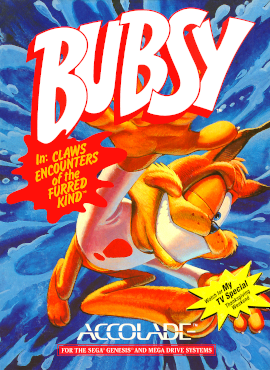
Bubsy in: Claws Encounters of the Furred Kind, often shortened to Bubsy, is a platform game first released for the Super Nintendo Entertainment System and Sega Genesis, and developed by Accolade in 1993. It is the first entry in the Bubsy series of video games. The game's title is a play on words in reference to the film Close Encounters of the Third Kind, with the game revolving around Bubsy defending the planet's supply of yarn balls from alien invaders.

Bubsy: The Woolies Strike Back is a platform game developed by Black Forest Games and published by UFO Interactive Games under the Accolade label. It was released for PlayStation 4 and Windows on 31 October 2017. The game is the fifth installment in the Bubsy series, and the first new entry in 21 years since Bubsy 3D.
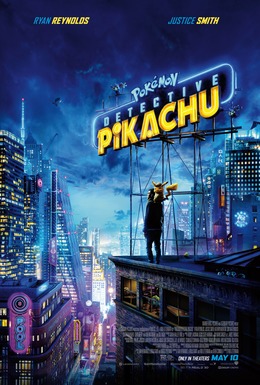
Pokémon Detective Pikachu is a 2019 fantasy film directed by Rob Letterman. Based on the Pokémon franchise, the film is a loose adaptation of the 2016 video game of the same name. It was written by Rob Letterman, Dan Hernandez, Benji Samit, and Derek Connolly, from a story by Hernandez, Samit, and Nicole Perlman, and produced by Legendary Pictures and Toho. It was the first live-action Pokémon film and the first live-action film based on a Nintendo game property since Super Mario Bros. (1993).

Spyro Reignited Trilogy is a 2018 platform game compilation developed by Toys for Bob and published by Activision. It includes remakes of the first three games in the Spyro series: Spyro the Dragon (1998), Spyro 2: Ripto's Rage! (1999), and Spyro: Year of the Dragon (2000). Reignited was released for PlayStation 4 and Xbox One in November 2018, while Nintendo Switch and Windows versions released in September 2019. The collection received positive reviews from critics and has sold over 10 million units as of September 2023.
References
- 1 2 "A History of Videogame Mascots". Paste. July 30, 2014. Archived from the original on July 2, 2015. Retrieved December 29, 2017.
- 1 2 3 4 5 6 7 8 9 10 11 12 "The Top Ten Best Video Game Mascots That You Probably Didn't Even Know Were Meant To Be Mascots". cinemablend.com. July 2, 2009. Archived from the original on December 29, 2017. Retrieved December 29, 2017.
- 1 2 3 4 5 6 7 8 9 10 11 "15 Forgotten Video Game Mascots From the 1990s". mentalfloss.com. October 4, 2017. Archived from the original on December 29, 2017. Retrieved December 29, 2017.
- ↑ Wehner, Mike (June 9, 2017). "One of the worst video game mascots is getting his first new game in 20 years". bgr.com. Archived from the original on December 29, 2017. Retrieved December 29, 2017.
- 1 2 3 4 5 6 7 8 Hartwig, Alex (March 22, 2016). "10 Lost Video Game Mascots: Where Are They Now?". Nerd Much. Archived from the original on December 29, 2017. Retrieved December 29, 2017.
- ↑ Semrad, Ed, ed. (May 1993). "Feedback - New Mascots". Super NES Buyer's Guide. Vol. 3, no. 3. Sendai Publishing. p. 8.
- 1 2 3 4 5 6 Martin, Liam (January 16, 2011). "Feature: Gaming's Most Iconic Mascots". Digital Spy . Archived from the original on August 7, 2018. Retrieved December 27, 2017.
- 1 2 3 4 5 6 7 8 9 10 11 12 13 14 15 16 17 18 19 "A History of Videogame Mascots". Paste . July 30, 2014. Archived from the original on July 2, 2015. Retrieved December 27, 2017.
- 1 2 3 "Did You Know The Origin Stories of These Famous Video Game Mascots?". smosh.com. Archived from the original on December 30, 2017. Retrieved January 3, 2018.
- 1 2 McWhertor, Michael (October 30, 2008). "Klonoa May Get Poochied For American Wii Release". kotaku.com. Archived from the original on September 1, 2018. Retrieved January 3, 2018.
- ↑ "E3 2011: Halfbrick Studios Demos 'Machine Gun Jetpack,' 'Fruit Ninja Frenzy' and 'Fruit Ninja Kinect'". gamerant.com. June 9, 2011. Archived from the original on December 28, 2017. Retrieved December 27, 2017.
- ↑ McWhertor, Michael (September 5, 2011). "Stop What You're Doing and Get Jetpack Joyride for Your iPhone Now". kotaku.com. Archived from the original on December 28, 2017. Retrieved December 27, 2017.
- ↑ "Hideo Kojima reveals the character behind the new Kojima Productions logo". Polygon. May 17, 2016. Archived from the original on October 26, 2021. Retrieved May 22, 2021.
- ↑ "2024年に30歳を迎える大谷翔平選手がKONAMI野球ゲームアンバサダーに就任". Konami. January 16, 2024. Archived from the original on January 20, 2024. Retrieved January 25, 2024.
- 1 2 3 4 5 6 7 8 9 10 11 12 13 14 15 16 17 18 19 20 21 22 23 24 25 26 Knight, Rich; Turner, Gus (August 23, 2013). "The Best Video Game Mascots of All Time25. Crash Bandicoot". Complex . Archived from the original on September 12, 2017. Retrieved December 27, 2017.
- ↑ "What did we do to deserve the PC-FX? (And the PC-FX GA)". Archived from the original on May 26, 2022. Retrieved April 21, 2022.
- ↑ Freidly, Damien (January 14, 2022). "What Everyone Forgets About Pikachu". ScreenRant. Archived from the original on January 20, 2022. Retrieved January 20, 2022.
- ↑ Kaliroff, Marc (January 5, 2022). "In 1993, Kirby's Adventure and Sakurai's "Kirbyism" Broke Ground". Goomba Stomp Magazine. Archived from the original on January 20, 2022. Retrieved January 20, 2022.
- ↑ "Super Sonico Celebrates Her 10th Anniversary with Sanrio". crunchyroll.com. Archived from the original on December 28, 2017. Retrieved December 27, 2017.
- ↑ Fahey, Mike (July 10, 2016). "Being A Virtual Gravure Idol's Personal Photographer Isn't Easy". Kotaku . Archived from the original on December 28, 2017. Retrieved December 27, 2017.
- ↑ Yeung, Karlie (August 30, 2010). "Pants vs. Pants, A Cultural Divide - Blog". Nintendo World Report. Archived from the original on January 20, 2022. Retrieved January 20, 2022.
- ↑ Luke Plunkett (April 6, 2011). "Remembering Sega's Exiled Mascot". Archived from the original on September 14, 2017. Retrieved February 27, 2020.
- ↑ McWhertor, Michael (March 25, 2020). "Sega has a new mascot with a cool history". Polygon. Archived from the original on March 25, 2020. Retrieved March 25, 2020.
- ↑ ""Angry Birds, Happy Planet" climate action campaign honored with The UN Foundation's Global Leadership Award". Rovio . October 19, 2016. Archived from the original on December 28, 2017. Retrieved December 27, 2017.
- 1 2 Shephard, Kenneth (February 17, 2017). "NIS America's Annual Press Event Brings News of 2017 Lineup". CGMagazineOnline.com. CGMagazine. Archived from the original on February 18, 2017. Retrieved February 17, 2017.
- ↑ Del Castillo, Chris (January 23, 2012). "Xbox 360 Version of Street Fighter X Tekken Could Have Had Master Chief or Marcus Fenix as Playable Fighters". Nerd Reactor. Archived from the original on December 30, 2017. Retrieved December 29, 2017.
It was originally announced that the PS VITA (and later PlayStation 3) version of Street Fighter X Tekken would add Cole MacGrath from Infamous and two of Sony's mascots, Kuro and Toro, as exclusive characters only on PS3 and VITA, and Microsoft fans were left wondering if they could expect a similar surprise.
- ↑ Purchese, Robert (August 13, 2008). "Sony grooming Sackboy to be face of PS3". Eurogamer . Gamer Network. Archived from the original on January 24, 2013. Retrieved August 13, 2008.
- ↑ "The Making Of: PlayStation - Edge Magazine". Next-gen.biz. April 24, 2009. Archived from the original on May 27, 2012. Retrieved January 16, 2016.
- 1 2 "Generation gone: Where PlayStation mascot Crash Bandicoot is today". Archived from the original on August 13, 2019. Retrieved August 13, 2019.
- ↑ "Review: Astro's Playroom". November 6, 2020. Archived from the original on November 23, 2020. Retrieved November 16, 2020.
- ↑ "Astro-Bot spinoff Astro's Playroom confirmed for PS5". Archived from the original on October 23, 2020. Retrieved November 16, 2020.
- ↑ "Here's Why PlayStation is Using Astro Bot in a Non-VR Game". October 6, 2020. Archived from the original on January 22, 2021. Retrieved November 16, 2020.
- ↑ "Is Astro Bot the Mascot of the PS4 Era?". October 3, 2018. Archived from the original on November 9, 2020. Retrieved November 16, 2020.
- 1 2 3 4 "Our 10 Favourite Japanese Video Game Mascots". ricedigital. August 4, 2020. Archived from the original on December 5, 2021. Retrieved May 22, 2021.
- 1 2 "15 Thing You Never Knew About Final Fantasy VII". screenrant. January 23, 2017. Archived from the original on April 18, 2021. Retrieved May 22, 2021.
- ↑ "Aero the Acro-Bat - Sunsoft". Electronic Gaming Monthly . Vol. 6, no. 49. Sendai Publishing. August 1993. p. 96.
- ↑ Isaac, Chris (December 2, 2015). "Interview: Shantae Co-Creator Matt Bozon Discusses the Series' Future & Shantae in Super Smash Bros". The Mary Sue . Archived from the original on December 3, 2015. Retrieved December 2, 2015.
- ↑ "Be Kind, Rewind: The Real Story Behind Blinx, Xbox's Mediocre Mascot". GamesRadar . April 4, 2017. Archived from the original on December 28, 2017. Retrieved December 27, 2017.
- ↑ Loh, Peggy (July 21, 2016). "Meet red, the Angry Birds mascot". New Straits Times . Malaysia. Archived from the original on December 28, 2017. Retrieved December 27, 2017.
- ↑ Pirrello, Phil and Monfette, Christopher (2008-05-12). Big Screen Big Daddy Archived December 8, 2013, at the Wayback Machine . IGN. Retrieved on 2020-04-16
- ↑ Tanaka, John (August 29, 2008). "Disgaea Mascot Featured in New PSP Title". IGN. Archived from the original on February 16, 2012. Retrieved November 27, 2008.
- ↑ "The 50 Greatest Video Game Characters". Empire. Archived from the original on November 2, 2012. Retrieved December 29, 2017.
- ↑ "The lesser-known videogames of famous designers". Den of Geek. May 14, 2013. Archived from the original on December 29, 2017. Retrieved December 29, 2017.
- ↑ "20 Most Popular Anime/Game Names to Give Children". animenewsnetwork. Archived from the original on October 3, 2023. Retrieved May 22, 2021.
- ↑ "Video Game Characters You Can Meet (Or Could Have Met) In Theme Parks". TheGamer. September 19, 2020. Archived from the original on February 4, 2021. Retrieved May 22, 2021.
- ↑ Yin-Poole, Wesley (November 9, 2012). "The rise of Sackboy, the mascot PlayStation has been searching for". Eurogamer . Gamer Network. Archived from the original on February 24, 2020. Retrieved February 24, 2020.
- ↑ Neil Foster (February 20, 2016). "Misadventures of Tron Bonne, The". Archived from the original on October 27, 2021. Retrieved September 23, 2021.
- ↑ "A History of Videogame Mascots". Paste. July 30, 2014. Archived from the original on March 8, 2021. Retrieved May 20, 2020.